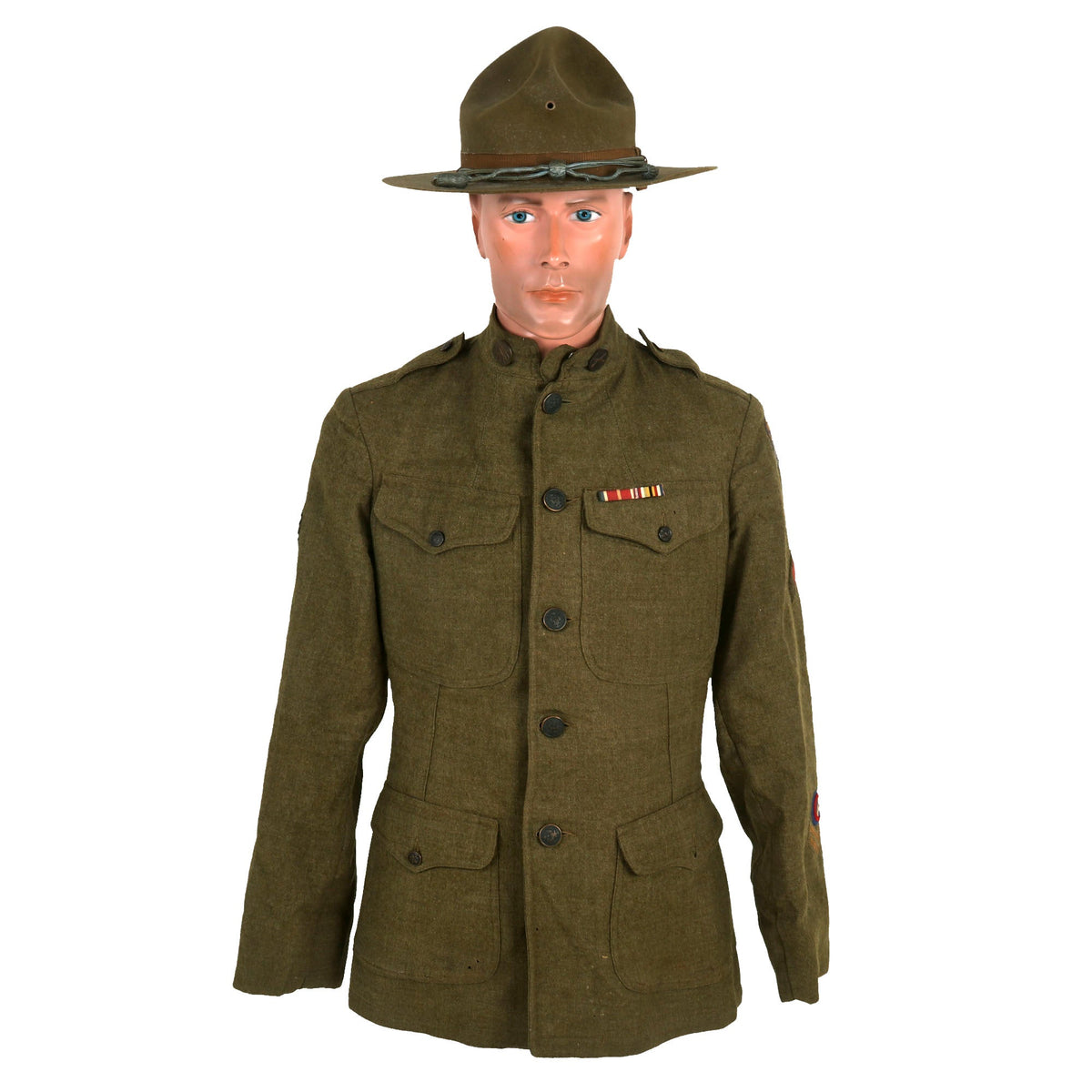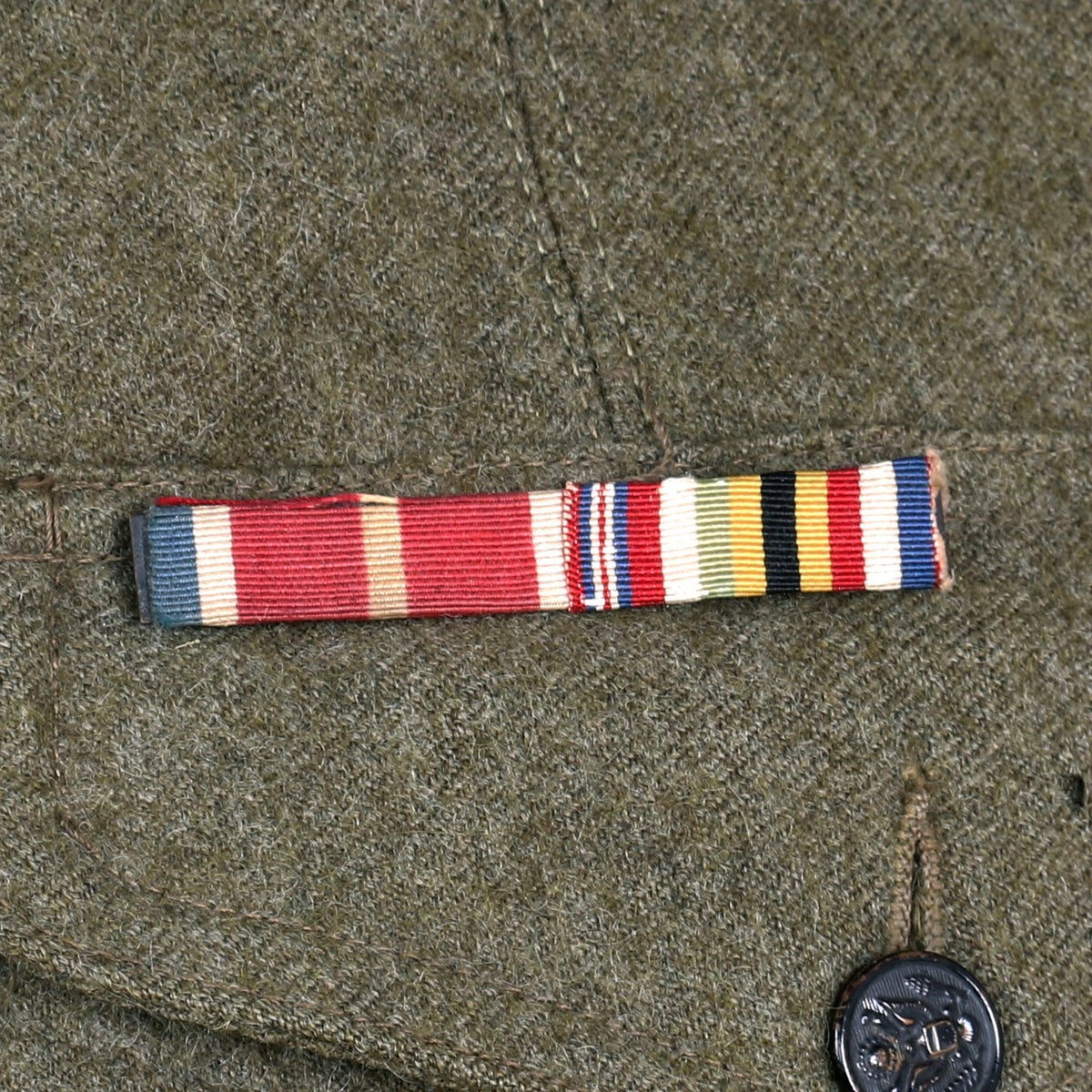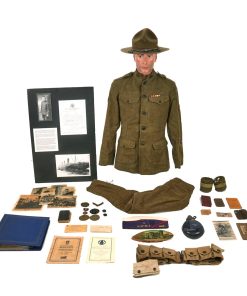Original Extensive WWI US Uniform Grouping Identified to Edward Charles Harms – 89th Division Double Patched Uniform Original Items
$ 1.495,00 $ 373,75
Original Item: Only One Available: This is one of the most extensive WWI uniform & ephemera groupings we have offered. This is the grouping of Edward Charles Harms, including his uniform, a captured Imperial German enamel canteen, a binder of original postcards and documents, and more.
This is a very extensive uniform grouping belonging to Edward Charles Harms, Serial #: 2182905, Company C, 354th Infantry Regiment, 89th Division. Included in this grouping is Harms’ Army uniform jacket & pants, which are in the exact condition and configuration as seen in the photos of Harms taken post-war. The jacket is in great condition with little mothing. His uniform jacket has the 89th Division patch denoting the 177th Infantry Brigade, including the 353rd and 354th Infantry Regiments. His patch also includes a small section covered by white, indicating that his brigade (177th) was voted “best in division”. He has two ribbons, his VFW ribbon and the unofficial Allied Victory ribbon. Also included are his original campaign hat with infantry cord, Mills cartridge belt with attached first aid pouch, puttees, a captured German blue Enamel canteen and German spare gas mask lenses, a bag filled with spare collar discs, 89th Division patches, and medals. His original Victory medal with 3 campaign clasps is included in the original box and paper. There are several more smalls, including his pocket bible, shaving mirror, and a rolled yardlong of his company likely taken in Germany. The binder has original documents, postcards, photographs, letters, newspapers, along with a good amount of post-war newspaper clippings, documents, and more. This is a phenomenal uniform grouping that is difficult to upgrade.
Approximate Measurements:
Collar to shoulder: 9″
Shoulder to sleeve: 26”
Shoulder to shoulder: 16”
Chest width: 18″
Waist width: 16″
Hip width: 1″
Front length: 30″
Pants:
Waist: 16″
Inseam: 27″
Edward Charles Harm was born on January 22nd, 1893, in Savannah, Illinois. He would move around often as a child, living in Leedy, Oklahoma at the time he was drafted. Thanks to a letter in the grouping, we know that Harms was living in West Plains, Missouri, after renting his father’s farm there. The letter is a response to his request to be deferred from the draft, stating that he knew he was liable to be called when he rented the farm, and that he had the responsibility of being called into service. Harms was reluctantly inducted into the draft on April 19th, 1918. He would be assigned to Company C, 354th Infantry Regiment, 89th Division. After training stateside, Harms went overseas on June 4th, 1918 aboard the HMAS Berrima.
During his time in France, Harms went through a great deal of combat with the 354th. He first entered the Lucey Defensive Sector on August 4th, 1918, remaining here until September 11th, the day before the St. Mihiel Offensive, which lasted from September 12-16th. Following this, Harms entered the Euvezin Defensive Sector and remained there from September 17th until October 7th. Following a week out of the sector, Harms entered the Meuse-Argonne Offensive on October 14th, remaining here until the end of the war on November 11th, 1918. The 89th Division, having distinguished itself greatly in combat, was chosen to become part of the 3rd Army tasked with the Occupation of Germany following the end of the war. They remained in Trier, Germany until May 15th, 1919, when the division returned stateside. Harms was discharged from the Army on June 3rd, 1919.
The 89th Division
The 89th Division was one of the National Army divisions, meaning it was made up primarily of men drafted from the states of Missouri and Kansas, but also included men from Colorado, Nebraska, South Dakota, and New Mexico. Due to his residence in Missouri at the time, Harms was grouped in with the men of the 89th Division.
The 89th Division was officially activated in August 1917, four months after the American entry into World War I, at Camp Funston, Fort Riley, Kansas, under the command of Major General Leonard Wood, formerly the Chief of Staff of the United States Army. Initial drafts of enlisted men came from Arizona, Colorado, Kansas, Missouri, Nebraska, New Mexico, and South Dakota. The division, now commanded by Major General William M. Wright, was sent overseas to join the American Expeditionary Force (AEF) in the final stages of World War I, which ended on November 11, 1918, due to the Armistice with Germany. The 89th Division, now under Major General Frank L. Winn, participated in the battles of St. Mihiel and the Meuse-Argonne Offensive. Two 89th staff officers would serve together in significant roles in WWII: Division Chief of Staff Col. John C. H. Lee, and his G-4 Supply Officer, Lt. Col. Brehon B. Somervell, who also received the Distinguished Service Cross (United States) for leading a three-man patrol to inspect damage to a bridge some 600 yards (550 m) in front of American lines. Lee served under Somervell in the Army Service Forces from 1942 to 1945. The 89th was inactivated in May 1919, after being in existence for just less than two years.
Fast Shipping with Professional Packaging
Thanks to our longstanding association with UPS FedEx DHL, and other major international carriers, we are able to provide a range of shipping options. Our warehouse staff is expertly trained and will wrap your products according to our exact and precise specifications. Prior to shipping, your goods will be thoroughly examined and securely secured. We ship to thousands clients each day across multiple countries. This shows how we're dedicated to be the largest retailer on the internet. Warehouses and distribution centres can be located throughout Europe as well as the USA.
Note: Orders with more than one item will be assigned a processing date depending on the item.
Before shipping before shipping, we'll conduct a thorough inspection of the items you have ordered. Today, the majority of orders will be delivered within 48 hours. The delivery time will be between 3-7 days.
Returns
The stock is dynamic and we cannot completely manage it because multiple stakeholders are involved, including our factory and warehouse. So the actual stock may alter at any time. It's possible that you may not receive your order once the order has been made.
Our policy is valid for a period of 30 days. If you don't receive the product within 30 days, we are not able to issue a refund or an exchange.
You can only return an item if it is unused and in the same state as the day you received it. You must have the item in its original packaging.
Related products
Uncategorized
Uncategorized
Band of Brothers ORIGINAL GERMAN WWII Le. F.H. 18 10.5cm ARTILLERY PIECE Original Items
Uncategorized
Uncategorized
Uncategorized
Uncategorized
Angolan Rebel 1970s era 60mm Inert Display Mortar from Angolan Civil War Original Items
Uncategorized
Uncategorized
Armored Burgonet Helmet & Polearm from Scottish Castle Leith Hall Circa 1700 Original Items
Uncategorized
Australian WWII Owen MK1 Machine Carbine SMG Custom Fabricated Replica with Sling Original Items
Uncategorized
Uncategorized
Uncategorized
Uncategorized
Uncategorized
Uncategorized
Uncategorized
Uncategorized













































































